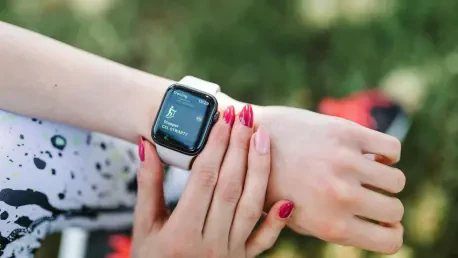Imagine a scenario where every step you take offers a glimpse into your overall health, much like a heartbeat or blood pressure reading provides vital clues to a doctor, and this isn’t a distant dream but a rapidly emerging reality, thanks to the powerful combination of artificial intelligence (AI) and wearable technology. These innovations are transforming human movement into a measurable and actionable vital sign, opening new frontiers in health monitoring and performance optimization. From athletes aiming to prevent injuries to patients recovering from debilitating conditions, the ability to analyze motion with unprecedented precision is reshaping how health and well-being are approached. This exploration dives into the technologies driving this revolution, their diverse applications, and the promising future of motion as a cornerstone of preventive care. The journey from raw data to life-changing insights is complex, yet the potential to enhance lives through these tools is undeniable, making this one of the most exciting developments in modern medicine.
The Technology Behind Motion Analysis
Decoding Movement with Precision Tools
The backbone of this health revolution lies in advanced tools like motion capture systems and wearable sensors, which have evolved far beyond the rudimentary stopwatches and visual assessments of the past. Embedded in devices such as smartwatches, inertial measurement units capture intricate details of movement—think stride length, cadence, and walking speed—with a level of accuracy that was once unimaginable. These sensors collect thousands of data points in mere seconds, creating a comprehensive picture of how the body moves in real time. This wealth of information serves as a foundation for understanding not just physical activity, but also underlying health conditions that manifest through subtle motion changes. By turning everyday actions into datasets, these technologies enable a shift from subjective observation to objective, data-driven analysis, paving the way for more informed decisions in both clinical and personal settings.
Equally remarkable is the integration of these tools into everyday life, making motion analysis accessible to a broader audience than ever before. No longer confined to specialized labs or elite sports facilities, wearable devices bring cutting-edge technology to the wrist or even the sole of a shoe. This democratization means that anyone, from a casual walker to a professional athlete, can benefit from detailed insights into their movement patterns. Beyond fitness tracking, the data harvested by these sensors holds potential for early detection of health issues, offering a proactive approach to wellness. The precision of these tools also allows for customization, tailoring feedback and interventions to individual needs. As technology continues to advance, the granularity of motion data will only improve, promising even deeper understanding of the complex interplay between movement and health across diverse populations and scenarios.
AI and Data Processing: From Noise to Insight
Raw data from wearable devices often arrives in a chaotic, unstructured form, riddled with noise that obscures meaningful patterns and renders it initially unusable for practical purposes. This is where signal processing plays a critical role, acting as a filter to strip away irrelevant information and clarify the underlying signals, much like sharpening a blurry photograph. Once cleaned, the data becomes a canvas for AI, specifically machine learning algorithms, which excel at identifying trends and relationships within vast datasets. These algorithms transform processed data into actionable health metrics, such as estimating fitness capacity from just a handful of steps. This eliminates the need for cumbersome, time-intensive testing, making health assessments more efficient and accessible to a wider range of individuals.
The power of AI extends beyond mere translation of data into metrics; it also enables predictive capabilities that can anticipate health challenges before they fully emerge. By analyzing patterns in movement, machine learning can flag anomalies that might indicate risks, such as a potential injury or the early onset of a neurological condition. This predictive edge is particularly valuable in settings where timely intervention can make a significant difference, from sports fields to rehabilitation centers. Furthermore, AI’s ability to continuously learn and adapt ensures that the insights provided grow more accurate over time, refining the technology’s utility. As these systems become more sophisticated, they promise to integrate seamlessly into daily routines, offering real-time feedback that empowers users to make informed decisions about their physical well-being without requiring specialized knowledge or equipment.
Applications Across Health and Performance
Personalized Medicine and Rehabilitation
In clinical environments, AI-driven motion analysis is proving to be a transformative force, enhancing the precision and effectiveness of patient care across a spectrum of conditions. For individuals recovering from strokes, wearable sensors paired with AI can monitor subtle improvements or setbacks in motor control, enabling tailored rehabilitation plans that adapt to each patient’s progress. Similarly, in managing chronic conditions like Parkinson’s disease, these tools provide detailed assessments of movement impairments, helping clinicians adjust treatments with greater accuracy. Beyond diagnostics, motion data informs the design of assistive technologies, such as exoskeletons, which support mobility for those with physical disabilities. This personalized approach marks a departure from one-size-fits-all solutions, focusing instead on individual needs to maximize recovery and quality of life.
The impact of these technologies in rehabilitation extends to preventive care within medical settings, addressing issues before they escalate into major health concerns. For elderly patients, motion analysis can detect early signs of fall risks by identifying irregularities in gait or balance, allowing for interventions like physical therapy or environmental adjustments. In pediatric care, these tools help track developmental milestones, ensuring that children with motor delays receive timely support. Hospitals and clinics are increasingly integrating wearable tech into routine checkups, making movement a standard metric alongside traditional vital signs. This shift not only enhances patient outcomes through early detection but also reduces the burden on healthcare systems by minimizing the need for emergency interventions. As adoption grows, the potential for motion data to revolutionize medical practice becomes increasingly clear, offering a more dynamic and responsive framework for health management.
Enhancing Sports and Military Performance
In high-performance arenas like sports, the marriage of AI and wearables is redefining how athletes train, compete, and recover by providing insights that were once out of reach. Machine learning algorithms analyze an athlete’s movement patterns in minute detail, identifying subtle deviations that could signal an impending injury, such as a stress fracture or muscle strain. This allows coaches and medical staff to implement preventive strategies, like adjusting training loads or refining technique, before an issue sidelines a player. Real-time feedback from wearables also optimizes performance during competition, offering data on fatigue levels or biomechanical efficiency. This technology is becoming a staple in professional sports, where maintaining peak physical condition can mean the difference between victory and defeat, fundamentally changing how teams approach player health.
Military applications of motion analysis are equally compelling, focusing on the unique physical demands faced by service members in rigorous and often hazardous environments. Wrist-worn wearables track biomechanics to pinpoint individuals at risk of overuse injuries, a common concern in training and combat scenarios where repetitive stress is unavoidable. By analyzing data on posture, gait, and load distribution, these tools inform personalized interventions, such as modified exercise regimens or equipment adjustments, to enhance resilience. The ability to monitor movement in real time also aids in tactical decision-making, ensuring that personnel are deployed based on their physical readiness. This not only improves individual safety but also boosts unit effectiveness, demonstrating how motion data can serve critical roles beyond civilian contexts. As military adoption of these technologies expands, the potential to reduce injury rates and improve operational outcomes becomes a strategic advantage.
The Future of Motion as a Vital Sign
Predictive Health Monitoring
The vision of treating motion as a continuous health indicator is gaining traction among researchers and technologists, with profound implications for how well-being is managed on a daily basis. Walking speed, for instance, has emerged as a surprisingly robust predictor of longevity and overall health, offering a simple yet powerful metric that reflects broader physiological trends. The ambition is to embed this capability into everyday items—think smartwatches or even footwear—that could alert users to potential issues like an impending fall or the early signs of a neurological disorder. Such predictive monitoring would enable timely action, potentially averting crises before they unfold. This approach shifts the focus from merely tracking activity to using movement as a proactive diagnostic tool, redefining personal health management in a way that prioritizes prevention over reaction.
Achieving this level of integration requires not only technological refinement but also widespread accessibility to ensure that benefits reach diverse populations. Imagine a scenario where a smart device alerts an elderly person to a balance issue, prompting a visit to a healthcare provider before a fall occurs. Similarly, for younger individuals, subtle changes in gait could signal overtraining or stress, prompting lifestyle adjustments. The scalability of predictive monitoring also holds promise for public health initiatives, where aggregated motion data could inform policies on aging or chronic disease management. While the technology is still evolving, the trajectory points toward a future where continuous health feedback becomes as routine as checking the weather, empowering individuals with real-time insights that enhance safety and longevity across all walks of life.
Redefining Preventive Care
Integrating motion data into daily life stands to revolutionize healthcare by shifting the paradigm from reactive treatment to proactive prevention, a change with far-reaching benefits. Picture a system where health issues are flagged before symptoms even appear—whether it’s a stroke risk in a middle-aged adult or declining mobility in an older individual. Wearables equipped with AI could analyze movement patterns over time, identifying trends that warrant early intervention, such as targeted physical therapy or lifestyle changes. This approach promises not only to save lives by addressing problems at their inception but also to reduce healthcare costs by minimizing the need for extensive treatments after conditions worsen. Preventive care, powered by motion as a vital sign, could become a cornerstone of modern medicine.
The broader societal impact of this shift cannot be overstated, as it addresses systemic challenges in healthcare delivery with innovative solutions. For instance, rural communities with limited access to medical facilities could benefit immensely from wearable tech that provides ongoing monitoring and alerts, bridging gaps in care. Additionally, employers might leverage anonymized motion data to design wellness programs that reduce workplace injuries, enhancing productivity while prioritizing employee health. Governments and health organizations could use large-scale data to track population health trends, informing resource allocation for at-risk groups. While the full realization of this vision requires overcoming barriers like data privacy and technological literacy, the groundwork laid by current advancements suggests a transformative path ahead, where prevention through motion analysis becomes an integral part of sustaining global health.
Overcoming Challenges for Wider Adoption
Despite the immense promise of motion-based health technologies, significant hurdles remain on the path to widespread adoption, demanding careful attention to practical and ethical considerations. The complexity of raw data from wearables poses a technical challenge, as it requires sophisticated processing to yield reliable insights, a process that can strain resources for smaller healthcare providers or individual users. Accessibility is another concern, as the cost of advanced devices and the infrastructure needed to support them may exclude lower-income populations or regions with limited technological reach. Addressing these disparities is crucial to ensure that the benefits of motion analysis are equitably distributed, preventing a scenario where only certain demographics can leverage these life-enhancing tools.
Equally important are the ethical dimensions surrounding data privacy and security, which must be navigated to build public trust in these technologies. Motion data, being deeply personal, raises concerns about how it is stored, shared, and potentially misused, especially as cloud computing becomes integral to real-time monitoring. Robust safeguards and transparent policies are essential to protect user information while maintaining the functionality of AI-driven systems. Additionally, user education plays a vital role, as many may lack the knowledge to interpret or act on the insights provided by wearables. Collaborative efforts between tech developers, policymakers, and healthcare professionals are needed to address these challenges, ensuring that the transition to motion as a vital sign is both inclusive and secure. Only through such measures can the full potential of these innovations be realized, transforming health monitoring into a universal standard.









